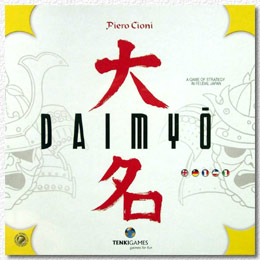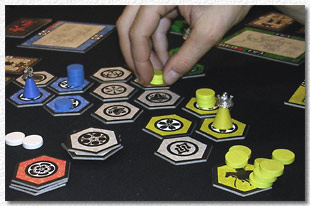
| Designer | Piero Cioni |
| Publisher | Tenki Games |
| released | 2005 |
| Players | 2-4 |
| Playing Time | 60 minutes |
 |
||||||||||
|
||||||||||
reviewed by Moritz Eggert
Samurai themed games are a constant staple of boardgames around the world. There is something fascinating about Japanese culture, about its vision of stylized beauty embedded in a strict code of honour and obligation.
"Daimyo" is one of the newest offerings using such a theme, this time by the Italian game company TENKIgames. The first thing one notices when opening the mainly white box is that the game could have been published easily in a box half or even 1/4th the size The couple of hexagon tiles and small cards along with very few wooden pieces don't really justify a box of this size, especially in an age where even "monster games" like the ones of Eagle games use relatively small boxes packed to the brim with plastic miniatures. The only plus is that this enables the rule book to be quite large, and in fact - very unusual for the usually awfully translated Italian games - this is an excellent rule book in 5 languages (English, German, French, Italian and Dutch) with great layout and many pictured examples. The German and English translations are excellent, and as far as I can tell the other translations are equally well done.
"Daimyo", the term for a Japanese "Archduke" so to speak, is at its heart an extremely abstracted wargame probably closest to chess, but with the added spice of a very elegant action card system that works really well.
Each player owns a Daimyo figure (the only non-abstract game piece - in fact the small "poeppel" with helm is quite cute) and tries to protect it from being slain. The game board is made up of generic tiles in either neutral colour or a player's colour. If two players play, probably the "truest" version of the game, the board is tiny, consisting of a diamond with only 9 hexes. With four players this increases to 20 hexes, still not a lot of room to manoeuvre.
Movement and actions are controlled by playing cards. The clever idea is that all action cards are numbered A-F and 1-8 or 1-4. No number appears twice, so there is definite order to the play of actions. Whoever owns the A1 card knows that this action is first, for example. Each round a maximum of two cards are played, a player might act twice in a row or in wide intervals, depending on the card numbers. At the end of a round a clever mechanic now makes the cards you used available to the players left and right of you, as each of them gets one of the cards you played. This makes for interesting decisions, as you basically know that a strong card that you just played might be played soon against you.
These are the actions of the basic cards:

| Characteristics | |
|---|---|
| Playing the game: | 60 minutes or less |
| Explaining the rules: | basic game 5 minutes, advanced games 10-15 minutes |
| Graphic design: | satisfying |
| Game Box: | too big but posh looking |
| Printed play help explaining the "Special Action Cards" and Daimyo abilities in 4 copies: | sorely missed, you have to refer to the rules all the time, which can become annoying with 4 players. |
| Luck: | If players are on equal terms dice rolls WILL decide the outcome of the game, if you don't like a little luck in games, stay clear from this one. But skill plays a higher role |
| How the Daimyo create the Bushi: | let's not think about it too much.... |
| Rules Layout/Translations: | excellent |
| Things we learned: | Han Solo apparently actually means "lonely fiefdom". What a bummer of a name! |
| Recommended for pure strategy fans, others might want to give it a try first. | |
Combat is simple and ruthless - simply an exchange of Bushi. If your Daimyo is "exchanged" in this way, the game immediately ends and the player who committed the kill wins. This is okay in a 2 player game, but in a 4 player game it has the problem of making the first person the winner who can exploit the mistake of another player, and the person doing this exploit will not necessarily be the best player.
When we played the game at Westpark Gamers we immediately moved on to the advanced rules which add distinct "Special Action Cards" which spice up the game (and also cycle through the players after you played them) and "Mastery" cards, that give each Daimyo an unknown (at least at first to the opponents) special ability. Gamers might want to immediately move on to these spice-adding rules as the basic game could be too abstract and dry for some.
There is nothing that doesn't work in this game, the rules are elegant and simple and it plays quite quickly in under an hour. I see a certain balancing problem in 3 or 4 player games, though. Usually games like this end in an always similar scenario. A attacks B, which leaves A and B weakened, then C comes in for the kill, attacking either A or B and wins. This comes down to "if you attack or ARE attacked first, you lose". Of course one can avoid to attack, but to avoid BEING attacked is not always an option. A winning strategy therefore has to be to avoid at all costs being A or B, but this would end in total stasis. With aggressive players the game ends quickly, mostly with C winning. If everybody waits until they feel sure they can attack with high odds the outcome is still the same, it just takes longer to get there. Or perhaps you will end up with nobody attacking at all and world peace comes along.
As "Daimyo" is so abstract and simplified this inherent multi-player wargame problem is more predominant than in dice and chaos dominated "Risk"-like games, which have exactly the same problem. The action cards and special abilities are therefore a step in the right direction, as they add asymmetrical elements.
All in all "Daimyo" can be recommended for players who are into abstract strategy games. Wargamers or historical gamers will find the setting a bit too pristine and dry; although the Japanese theme is well realized. Eurogamers will feel at home with the mechanics, but might find the antagonistic game play unattractive. You have to decide for yourself if you want to be a Daimyo or not, but the game makes it easy to get into, so you might as well give it a try.
| add/read comments |
©2006, Westpark Gamers